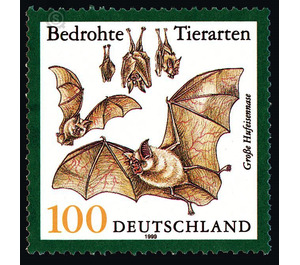Endangered species in Germany - Germany / Federal Republic of Germany 1999 - 100 Pfennig
Theme: Animals
| Country | Germany / Federal Republic of Germany |
| Issue Date | 1999 |
| Face Value | 100.00 |
| Perforation | K 13 1/4 |
| Printing Type | offset |
| Stamp Type | Postage stamp |
| Item Type | Stamp |
| Chronological Issue Number | 1959 |
| Chronological Chapter | GER-BRD |
| SID | 576810 |
| In 52 Wishlists | |
This bat owes its name to a horseshoe-shaped skin flap in the nose area, which, together with other structures, supports the echolocation system. The large horseshoe nose weighs 17 to 30 grams and has a wing span of no more than 40 centimeters. Characteristic are the large, flesh-colored and pointed ears with eight to nine transverse folds. The eyes are small and are dominated by intricate nose structures and long facial hair. The face of the bat has a goblinish expression. Her coat is long and soft. The Large Horseshoe Nose uses spacious, warm and draft-free attics in summer. Their hunting habitats lie in warm-favored plains and slopes with loose trees and shrubs, orchards, pastures, banks and gardens. In winter, the bat usually retreats to cave quarters for hibernation. Like other bats, the large horseshoe nose feeds mainly on insects and spiders, which are usually caught in flight, but occasionally picked from leaves and from the ground. Main bag groups are beetles and butterflies. For orientation and hunting, bats use ultrasound orientation sounds that are between 80 and 85 kilohertz, which is far above human hearing. The main focus of the Great Horseshoe Nose is in the Mediterranean and in the Balkans, northernmost deposits occur in southern England. In Germany, the big horseshoe nose is almost extinct.


